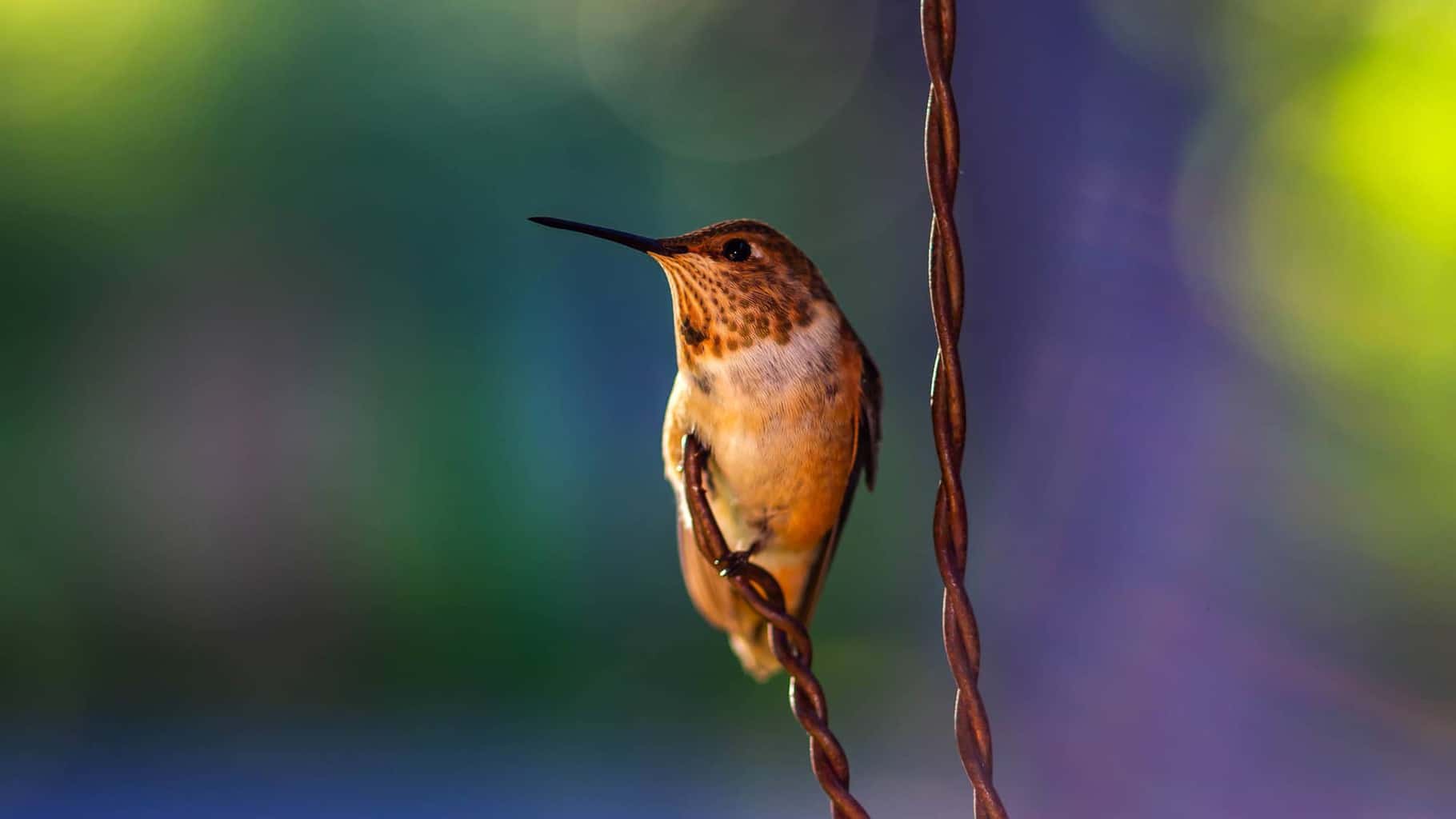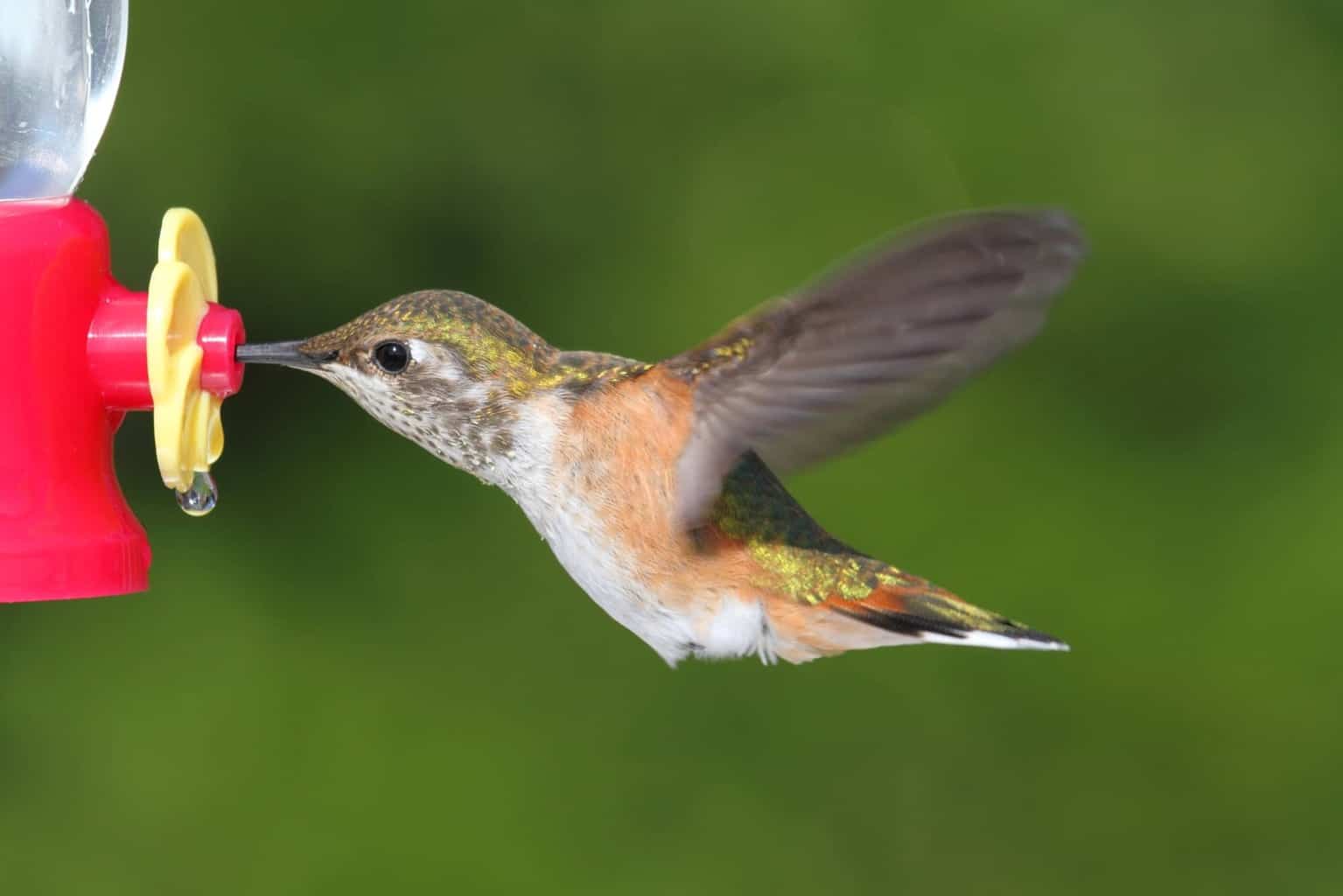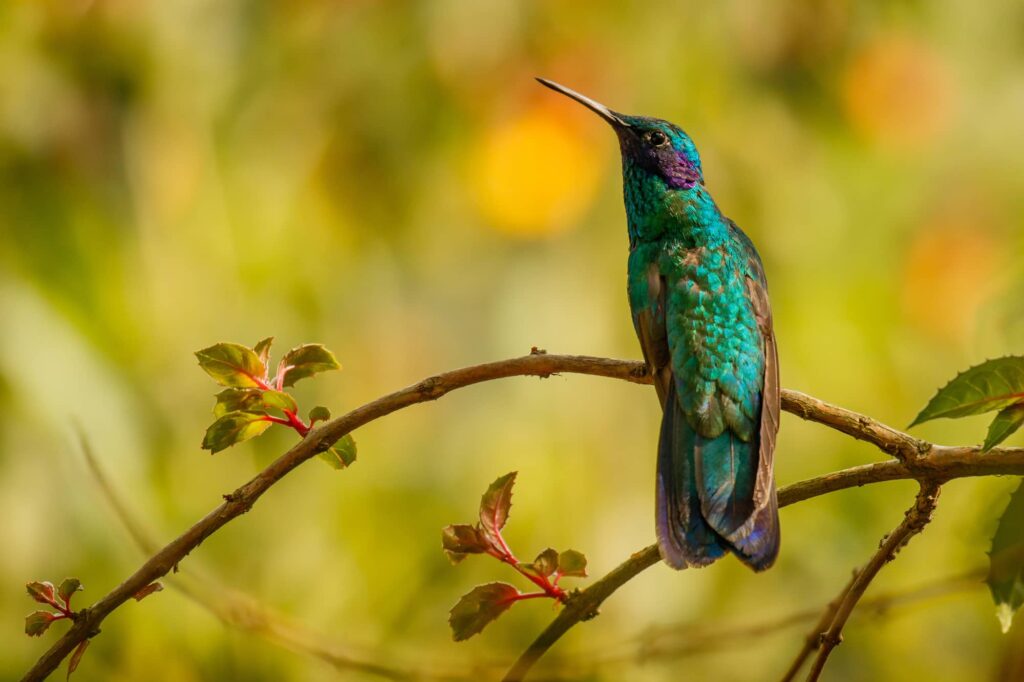Illinois is a midwestern state in the United States nicknamed the “Prairie State.” The state has beautiful forest areas, farmlands, wetlands, and rolling hills. Illinois’ beauty and charm are in the abundance of chatty birds roaming the air and perching on trees.
According to the Illinois Ornithological Records Committee, the state officially recognizes 451 species of birds. Six species of hummingbirds are a part of this group. There are two primary or seasonal species, and the remaining four are vagrant or accidental visitors.
You’ll be able to find hummingbirds in Illinois from May to September or October. If you’re trying to identify the iridescent hummingbird species whirring around your garden, or you’d like to keep a close eye out for one of these beauties on your park run or hike, stay tuned.
Ruby-Throated Hummingbird

- Scientific Name: Archilochus colubris
- Length: 2.8 to 3.5 inches
- Weight: 3.4 grams for males and 3.8 for females
- Wingspan: 3.1 to 4.3 inches
Ruby-throated hummingbirds have bright green feathers on their backs and crowns. The males have brilliant ruby-red gorgets, whereas the females have a plain, grey to white gorget with faint dusky streaks.
Additionally, Ruby-throated hummingbirds have solidly black chins and bills with distinctive forked tails. Juvenile male Ruby-throated hummingbirds resemble adult females.
These popular birds are common in Illinois during the warm summer months, usually arriving in late April and early May. The males typically arrive one or two weeks earlier than the females.
Female Ruby-throated hummingbirds build their nests out of thistle and dandelion down held together with spider silk. They perch their nests on dainty branches of forest trees. They lay one to three tiny eggs measuring only 0.6 inches long.
Weighing as little as a penny, this common hummingbird migrates on an incredible 500-mile journey across the Gulf of Mexico to reach its summer breeding grounds.
These beautiful birds tend to be aggressive in defense of their favorite native nectar-filled flowers and nectar feeders. As a result, they generally do not stick around for long; they migrate by early August after mating.
Rufous Hummingbird

- Scientific Name: Selasphorus rufus
- Length: 3.5 inches
- Weight: 2 to 5 grams
- Wingspan: 4.3 inches
Male Rufous hummingbirds have white breasts and rufous crowns, flanks, and tails (hence the common name) with iridescent copper-red throats. In addition, some of the males may have a greenish wash on their crown and back.
In comparison, female Rufous hummingbirds are typically slightly larger than males. They have green crowns and backs and white, somewhat speckled throats with a central orange splotch. Additionally, the females showcase dark tails with white tips and a rufous base.
Rufous hummingbirds are casual vagrants to the state of Illinois. They are, however, mostly spotted in Chicago. They have the longest migration routes of all migrating hummingbirds in the United States, traveling over 4,000 miles from northwest Alaska to Mexico and the Gulf Coast, and back.
Known for their aggressive nature, Rufous hummingbirds are among the feistiest hummingbirds in North America. Both males and females are relentless attackers that produce high-pitched, chipping, or chattering vocalizations as part of their threat display. This territorial hummingbird will defend itself against larger hummingbirds and even predatory birds.
Rufous hummingbirds get their primary food source, sweet nectar from colorful tubular flowers, using their long, extendable tongues to reach the nectar. So, entice these whimsical birds with nectar-rich tubular plants, like anise sage, beebalm, and hummingbird mints.
Anna’s Hummingbird

- Scientific Name: Calypte anna
- Length: 3.9 to 4.3 inches
- Weight: 2.8 to 5.7 grams
- Wingspan: 4.7 inches
Male Anna’s hummingbirds have a glossy, iridescent pinkish-red crown, gorget, and neck that appear almost black depending on the lighting. The chest, abdomen, and flanks are grayish with a green tint. Lastly, they have a pale, broken eye ring and dusky black-brown wings and tails.
Females have a pale chest with white and red spotting on the gorget, a green head, back, and a white-tipped tail. Male juvenile Anna’s have a similar appearance to the females and gradually develop their adult iridescent ruby hoods.
Anna’s hummingbird is of the most talkative hummingbirds in the United States. They are an accidental visitor species to Illinois and have only been spotted a few times. They prefer low mountain slopes.
Anna’s hummingbirds are well-known for their territorial behavior, making elaborate and dramatic diving displays with a burst of loud sound trailing from their tail feathers to ward off other birds. They are one of few hummingbird species that produce a song with a series of scratchy noises that sound like sharp metallic “chip” vocalizations.
Anna’s hummingbirds get their name from the 19th-century Italian duchess Anna Massena.
Mexican Violetear

- Scientific Name: Colibri thelassinus
- Length: 3.8 to 4.7 inches
- Weight: 4.8 to 5.6 grams
- Wingspan: 4.7 inches
Mexican violetears have overall emerald or metallic green plumage with dark violet patches on their cheeks and breasts. It is a medium-sized hummingbird commonly found in forested areas from Mexico to Nicaragua. These little birds are a rare sight in Illinois; they were last recorded in Illinois over ten years ago.
The Mexican violetear’s preferred habitat is the forest areas of Mexico and Central America, down to Nicaragua. Still, you can find them roaming as far south as the mountainous regions of Bolivia and Venezuela.
This beautiful hummingbird typically enjoys foraging alone, feeding at mid-level canopies in deforested areas. However, they sometimes gather at flowering trees, especially coffee-shade Inga.
Mexican violetears are pretty vocal hummingbirds that sing a jerky, metallic, chipping song from exposed twigs in their territorial areas. Additionally, the male Mexican violetear is territorial and flies in an interesting u-shape pattern to court females and get their attention.
Broad-billed Hummingbird

- Scientific Name: Cynanthus latirostris
- Length: 3.1 to 3.9 inches
- Weight: 3 to 4 grams
- Wingspan: 5.1 inches
Broad-billed hummingbirds have long, broad, bright red beaks with black tips and brilliantly colored bodies. The males are a rich metallic dark green with a sapphire blue throat that reaches down to their breast and white undertail coverts. The females are generally less colorful, with a pale belly and whitish eye stripes running over each eye.
This southwestern hummingbird is an accidental or vagrant migrator in Illinois, only spotted a few times.
Both male and female Broad-billed hummingbirds are chatty birds that produce a call that sounds like a swift “chi-dit.” They are of the most mild-tempered birds, but occasionally they will aggressively protect nectar-rich areas by using fascinating aerial flights and fascinating intimidating displays to ward off other hummingbirds or giant insects.
The Broad-billed hummingbird is a famous backyard bird feeder visitor. But, it primarily feeds on native flowers rich in nectar from a wide variety of vibrantly colored and sweetly-scented exotic flowers. So, consider planting a few native plant species in your hummingbird garden to attract a beautiful Broad-billed hummingbird.
Allen’s Hummingbird

- Scientific Name: Selasphorus sasin
- Length: 3 to 3.5 inches
- Weight: 2 to 4 grams
- Wingspan: 4.3 inches
Male Allen’s hummingbirds have a green back and forehead with iridescent reddish-orange gorgets and rust-colored bellies, tails, and eye patches. The females lack a bright throat patch.
Additionally, male and female hummingbirds have elongated straight bills and coppery-green backs. Additionally, juvenile Allen’s hummingbirds look strikingly similar to female Rufous hummingbirds, making it quite challenging to tell them apart.
Allen’s hummingbird is a small hummingbird species that breed in the mountainous habitats of the western United States. Moreover, Allen’s hummingbirds are an accidental species in Illinois, and they have only been spotted a handful of times in winter.
The Allen’s hummingbird has the most restricted breeding range of all North American hummingbirds. Males are aggressive and territorial birds that will chase other male birds up to several times larger than themselves to protect their territory.
Allen’s hummingbird gets its common name from Charles A. Allen, a famous Californian bird collector.
In their natural environment, Allen’s hummingbirds feed on native plant species like honeysuckle, fuchsia-flowered gooseberry, and other flowers rich in nectar.
Conclusion
There you have it, the six types of hummingbirds found in Illinois. Although many hummingbirds are vagrant and rare, the Ruby-throated hummingbird is a pretty common sight in Illinois, usually arriving from late April to May.
Arkansas is rich with vibrantly colored birds. So, if you’re an avid birder, jump over to our next exciting read on the 35 most popular species in Illinois.

